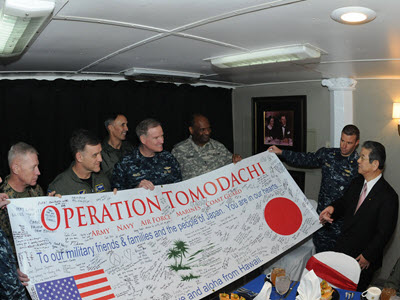Timeline of Operation Tomodachi
In the weeks following the earthquake and tsunami that struck Japan on March 11, 2011, the combined U.S.-Japan military relief effort—Operation Tomodachi—was chronicled on the NBR website. This project archive details the successful execution of Operation Tomodachi.
On the eve of the tenth anniversary of the triple disaster, recent Deputy Assistant Secretary of Defense for East Asia Heino Klinck commented on the significance of Operation Tomodachi for the U.S.-Japan alliance at a private event for NBR. Listen to those remarks here.
March 11–April 8, 2011
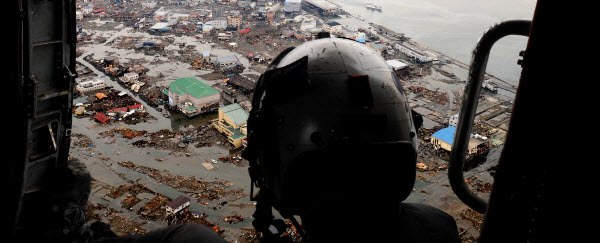
On March 11, 2011, at 14:46 Japan Standard Time, a 9.0 magnitude earthquake occurred 81 miles to the east of Sendai, Japan. Over the course of the crisis, the United States and Japanese governments engaged in far-reaching cooperation, providing relief and aid to the affected areas of northeast Japan.
The heart of the U.S-Japan alliance, since the establishment of the alliance in 1951 with the U.S.-Japan Mutual Security Treaty (MST), resides in the collaborative work undertaken by the U.S. military and the Japan Self Defense Forces (JSDF). Operation Tomodachi (トモダチ作戦) was the U.S. Armed Forces operation that supported Japan in disaster relief following the 2011 Tohoku earthquake and tsunami. Tomodachi is Japanese for “friend,” indicating the deep nature of the relationship.
The National Bureau of Asian Research (NBR) began tracking developments in Japan shortly after news of the earthquake and tsunami reached the United States. In the following weeks, Operation Tomodachi was chronicled on the NBR website. The resulting chronology, which details the successful execution of Operation Tomodachi, is archived below.
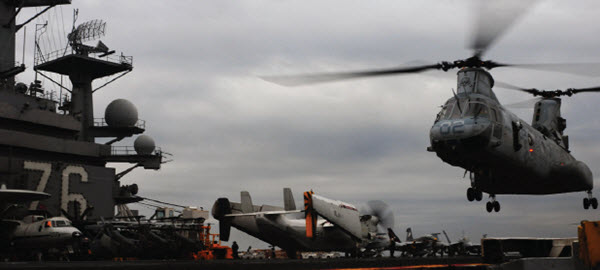
A CH-46E Sea Knight helicopter takes off from the USS Ronald Reagan.
Friday, March 11, 2011
- CH-46E Sea Knight helicopters with Marine Medium Helicopter Squadron 265, III MEF, depart Marine Corps Air Station Futenma for Naval Air Facility Atsugi on Honshu.
- The USS Ronald Reagan Carrier Strike Group (consisting of the USS Chancellorsville, the USS Preble, and the USNS Bridge) departs for the Japanese island of Honshu.
- The USS Ronald Reagan, stationed off the coast of Japan, works together with the JSDF to provide refueling support and transport for JSDF troops.
- The USS McCampbell and USS Curtis Wilbur, stationed at sea near Japan, prepare to move into position to aid in at-sea rescue efforts with Japanese authorities.
- The USS Tortuga, stationed in Japan, departs for Korea to pick up heavy-lift helicopters to assist in relief efforts.
- The USS Essex, having just arrived in Malaysia, departs for Japan.
- The USS Blue Ridge, the U.S. Seventh Fleet command ship, departs Singapore for Japan carrying relief and humanitarian equipment loaded at port.
- The USS Harpers Ferry and the USS Germantown redirect from locations in Southeast Asia to Japan.
- U.S. Forces Japan, based at Yokota Air Base near Tokyo, coordinates humanitarian assistance.
- U.S. Air Force and Marine helicopter and transport aircraft are moved from Okinawa to U.S. military bases on Honshu.
- The 31st Marine Expeditionary Unit and Amphibious Squadron 11 embark for the coast of Japan.
- C-130 aircraft of III Marine Expeditionary Force are sent to the affected region of Japan.
- The U.S. Agency for International Development (USAID) dispatches two urban search-and-rescue teams to Japan.
- U.S. nongovernmental aid organizations begin coordinating with civil society groups in Japan to help with disaster relief.
Sunday, March 13, 2011
- The USS Ronald Reagan Carrier Strike Group (consisting of the USS Chancellorsville, the USS Preble, and the USNS Bridge) arrives in Japan.
- Two SH-60 Seahawk helicopters from the U.S. Naval Air Facility Atsugi deliver 1,500 pounds of rice and bread to the affected region.

Ticonderoga-class guided-missile cruiser USS Chancellorsville underway off the coast of Japan.
Monday, March 14, 2011
- The USS Ronald Reagan and the Carrier Strike Group (USS Chancellorsville, USS Preble, USNS Bridge) move downwind from Fukushima in response to radiological concerns emanating from the damaged Fukushima nuclear plants. They are about 180 nautical miles away from the Fukushima nuclear complex.
- The USS Fitzgerald, USS John S. McCain, USS McCampbell, and USS Curtis Wilbur operate in the nearby vicinity of the USS Ronald Reagan Carrier Strike Group.
- The USS Mustin (DDG 89) operates in seas south of the disaster site.
- 50,000 U.S. military personnel are operating in Japan providing disaster relief.
- Eight of the thirteen U.S. military ships mobilized on March 11 operate off the coast of Honshu, with more en route: the USS Tortuga (three days out), USS Essex (two days out), the USS Blue Ridge (two days out), the USS Harpers Ferry (two days out), and the USS Germantown (two days out).
- P-3 Orion aircraft fly survey missions of the affected area.
- Air operations consisting of 10 helicopters from the Naval Station in Atsugi and the USS Ronald Reagan fly relief missions in the Minato region.
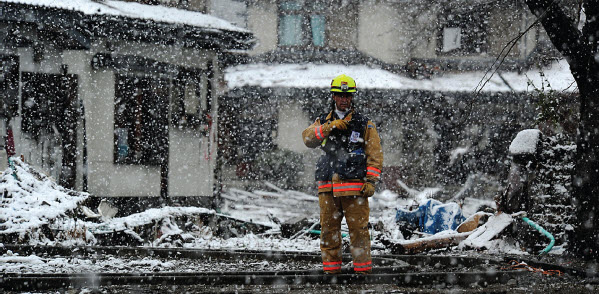
A member of a FEMA Urban Search and Rescue Task Force searches structures and debris in Kamaishi, March 16, 2011.
Wednesday, March 16, 2011
- A joint JSDF/U.S. military helicopter operation to pour water over the damaged Fukushima nuclear plants is called off in response to the growing radiation hazard.
- Fourteen U.S. Navy ships and their aircraft, and 17,000 sailors and Marines provide humanitarian assistance and disaster relief to Japan.
- The military effort includes 113 helicopter sorties and 125 fixed-wing sorties, moving people and supplies, helping in search and rescue efforts, and delivering 129,000 gallons of water and 4,200 pounds of food.
- The USS Tortuga, with 300 JSDF personnel and 90 vehicles onboard, is expected to arrive near the affected area in one day and begin operations.
- The USS Blue Ridge is expected to arrive in one day.
- The USS Harpers Ferry, the USS Essex, and the USS Germantown, transit and begin to operate on the western side of Honshu away from the radiation hazard caused by the Fukushima nuclear plants and the at-sea debris field on the eastern side of Honshu.
- The USNS Safeguard delivers high-pressure water pumps to Yokota Air Base for transfer to the Japanese government for use at the Fukushima power plant.
- U.S. Air Force C-17s and C-130s deliver 19 generators to Misawa Air Base for the base’s power system and resupply pallets to Yokota Air Base.
- The U.S. Army Corps of Engineers, Japan District, provides an administration system to help the U.S. Army Japan disaster assessment team with debris-removal efforts.
- The USS Ronald Reagan and the USS Ronald Reagan Carrier Strike Group reposition to the north but continue to operate in the affected area.
- The 31st Marine Expeditionary Unit begins preparations for clean-up at the Sendai airport.
- The U.S. Military provides two fire trucks for use by Japanese authorities.
- A squadron from Marine Corps Air Station Yuma in Arizona is called upon to provide relief efforts.
- The U.S. Air Force’s Air Mobility Command forces are placed on alert to support relief operations in Japan.
- Forces from the 615th Contingency Response Wing at Travis Air Force Base, California are put on alert should additional needs arise in Japan.
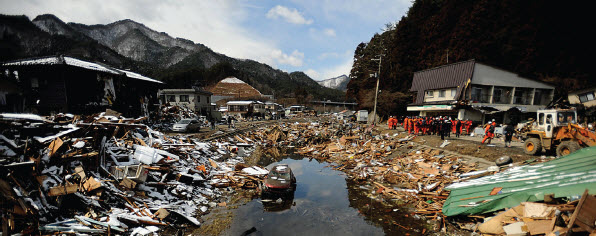
Debris and wreckage is piled up in Unosumai, March 17, 2011.
Thursday, March 17, 2011
- 15 U.S. ships and thousands of naval, ground and air force personnel work to help Japan deal with the damaged nuclear reactors and the humanitarian crisis caused by the earthquake and tsunami.
- Admiral Robert Willard, commander of U.S. military forces in the Pacific, calls the current joint relief effort a “natural fit”, but acknowledges that the triple disasters—the earthquake, tsunami and meltdown threat—go beyond anything the two militaries have ever practiced dealing with.
- Unmanned drones monitor radioactivity levels over the damaged Fukushima nuclear power plant.
- Ground Self Defense Forces mitigate the developing situation surrounding the Fukushima nuclear power plant with aid from U.S. armed forces.
- A U.S. Global Hawk drone and U2 spy plane measure the radiological threat caused by the compromised Fukushima nuclear power plant.
- A nine-member U.S. military team arrives in Japan from U.S Northern Command to conduct a broad assessment of the disaster area, including the damaged Fukushima nuclear power plant.
- 450 radiological and disaster-management experts prepare to offer assistance after an initial assessment by the nine-member team.
- Commander Naval Forces Japan (CNFJ) Regional Fire Department sends a Morita 1,000 gallon structural engine (firefighting) to Fukushima City located in the northern region of Honshu, Japan.
- The U.S. Navy provides five high-capacity pumping systems to Japan’s Electrical and Mechanical Engineering Group Nuclear Asset Management Department to help cool the core of the damaged No. 3 reactor at the Fukushima nuclear power plant.
- Defense Secretary Robert M. Gates authorizes up to $35 million in initial Defense Department funds for humanitarian aid to Japan.
- A U.S. Army ground commander creates a “joint task force” with leaders of the Japanese Self-Defense Force.
- The USS Blue Ridge arrives in Japan.
- The amphibious dock landing ship USS Germantown in the Sea of Japan received 85 pallets of food and fuel March 17 from various relief organizations.
- The USS Tortuga arrives in the affected areas and begins to assist in the relief effort, delivering 93 vehicles and 273 Japanese soldiers ashore by landing craft near Ominato in northern Japan. The ship is bringing 5,000 bottles of water and 5,000 meals to Misawa for further distribution.
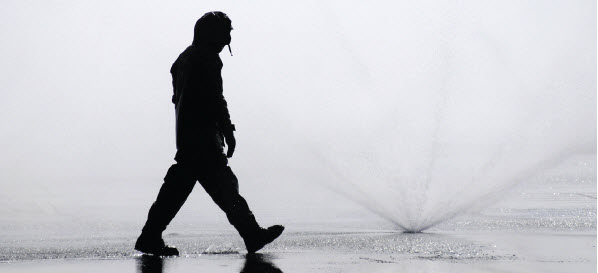
U.S. Navy personnel check sprinklers during a radiation scrub on the flight deck of the USS Ronald Reagan.
Friday, March 18, 2011
- 4,000 additional marines and sailors with the 31st Marine Expeditionary Unit and Amphibious Squadron 11 arrive off the coast of western Japan.
- More than one dozen aircraft relocate to Naval Air Facility Misawa in northern Japan from Naval Air Facility Atsugi and Kadena Air Base in southern Japan. A total of 13 helicopters and about 500 sailors reposition to Misawa, doubling the base’s population.
- Ships from the USS Essex Amphibious Ready Group arrive off the coast of western Japan with more than 150 amphibious vehicles and 25 aircraft.
- The USS Tortuga delivered 93 vehicles and 273 Japanese soldiers ashore by landing craft March 17 near Ominato in northern Japan. The ship is distributing 5,000 bottles of water and 5,000 meals to Misawa for further distribution.
- Lt. Cmdr. Derek Peterson, U.S. 7th Fleet salvage officer, visits Hachinohe, Japan, and meets with city officials to discuss the salvage capabilities the U.S. Navy can provide in support of Operation Tomodachi.
- Aircraft assigned to Carrier Air Wing (CVW) 5 continue to arrive at Anderson Air Force Base as part of the Navy’s force posture adjustment for Operation Tomodachi.
Saturday, March 19, 2011
- At present approximately 17,000 U.S. military personnel and 100 plus aircraft are involved or prepared to assist in relief operations in Japan.
- Sailors and Marines aboard the aircraft carrier USS Ronald Reagan (CVN 76) collect donations to supply displaced Japanese citizens with essential goods for survival.
- USS McCampbell (DDG 85) continues its Humanitarian Aid and Disaster Relief operations off the east coast of the Iwate Prefecture.
Sunday, March 20, 2011
- The 31st Marine Expeditionary Unit (MEU) and Amphibious Squadron 11, with a combined total of more than 4,000 Marines and Sailors, transit to the east coast of mainland Japan. The 31st MEU includes more than 2,200 Marines and Sailors and is comprised of four elements: the Command Element; Battalion Landing Team 2nd Battalion, 5th Marines; Marine Medium Helicopter Squadron 262 (Reinforced); and CLB-31. The 31st MEU provides a forward-deployed, flexible, sea-based force capable of supporting the ongoing Japanese humanitarian assistance and disaster relief operations as directed.
- USS Essex (LHD 2), USS Harpers Ferry (LSD 49) and USS Germantown (LSD 42) with the embarked 31st MEU arrive off the coast near Hachinohe city, preparing to assist humanitarian aid efforts along the affected northeastern coast.
- Helicopters with Marine Medium Helicopter Squadron 262 (Reinforced), 31st MEU, fly from USS Essex (LHD 2) as it draws near the eastern coastline. The helicopter crews deliver humanitarian aid supplies, including blankets and fresh water, to Miyako city.
- The 31st MEU survey areas around the northeast towns of Ofunato, Kamaishi, and Miyako in order to assess disaster relief needed in those areas.
- The six-man forward command element of the 31st MEU is now in Sendai, Japan, in order to coordinate disaster aid planning with officials already on scene.
Monday, March 21, 2011
- The American Red Cross, The Salvation Army, the International Medical Corps, and other nonprofits are pursuing mobile donation efforts with groups such as the Give Foundation, the Mobile Giving Foundation, and Mobile Cause to provide aid to Japan.
- AT&T and other carriers are offering conditional free phone calls from the United States and Puerto Rico to Japan until March 31, 2011
- Ichiro Suzuki, a Japanese baseball superstar with the Seattle Mariners, has donated ¥100 million ($1.24 million) to the Japanese Red Cross toward the relief effort.
- Disaster relief charity ShelterBox is providing emergency accommodation for up to 10,000 people, including accommodation for 1000 refugees in the towns Miyako, Yamada, Kamaishi, Rikuzentakata and Ofunato.
- The State Department has moved its embassy operations during the crisis, set up contact information systems, and issued travel advisories.
- Aircraft assigned to Carrier Air Wing 5 have been arriving at Anderson Air Force Base as part of the Navy’s force posture adjustment for Operation Tomodachi.
- Members of a radiological assistance team are working to monitor crewmembers at risk for exposure to radioactivity on the USS Essex, USS Harper’s Ferry, and USS Germantown.
- USS George Washington left Yokosuka and is scheduled to remain in local waters off Japan.
- Ships of the Essex Amphibious Ready Group (ARG) and embarked Marines of the 31st Marine Expeditionary Unit arrive off the northeast coast of Japan’s Honshu island. The Essex ARG is comprised of the USS Essex, USS Harpers Ferry, USS Germantown, and USS Tortuga.
- Two UH-1N Huey helicopters from the 31st MEU conduct surveys of the Hachinohe coastline.
- After vertical replenishment with USNS Matthew C. Perry, the USS Essex launches four CH-46 Sea Knight helicopters from the 31st MEU to deliver 800 gallons of potable water and 768 blankets ashore.
- USS Tortuga is off the coast of Hachinohe serving as a floating forward service base for helicopter operations. Two MH-53s from HM-14 pick-up and deliver 15 tons of supplies from Misawa Air Base to Yamagata Station. It is expected to conduct a replenishment with USNS Matthew Perry, which is carrying 189 pallets of humanitarian supplies which it plans to deliver to the Essex ARG and Reagan Strike Group over the next several days.
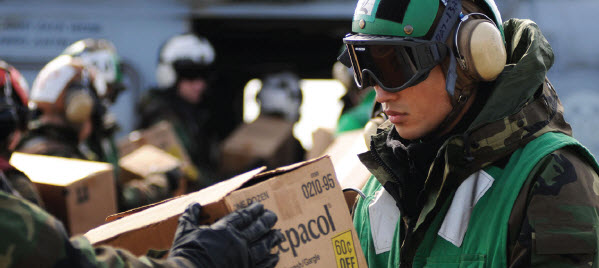
U.S. Navy airman loads supplies into a helicopter aboard the USS Ronald Reagan.
Tuesday, March 22, 2011
Commander of U.S. Pacific Command Admiral Robert Willard and his wife Donna arrived in Japan on Saturday, March 19. He is there reinforcing America’s support for Japan, overseeing disaster relief efforts, interfacing with U.S. Ambassador John V. Roos, and visiting U.S. forces and their dependents. On March 22, Admiral Willard visited the disaster area.
- Admiral Willard addresses the community in Yokosuka on the current situation with the Fukushima nuclear-power plants, voluntary departure of dependents, and thanks families for their support to sailors engaged in Operation Tomodachi.
- More than 100 U.S. sailors, marines and civilians throughout Navy Region Northwest work with their Army and Air Force counterparts, other agencies, and volunteers from the USO and American Red Cross in Seattle. Teams are providing assistance to the more than 120 family members who arrived in Seattle from Japan as part of Operation Tomodachi. Thousands more are expected to arrive over the coming days.
- The National Guard is increasing its personnel and equipment in support of Operation Tomodachi. The Mississippi Air National Guard’s 172nd Airlift Wing deployed a C-17 Globemaster III, March 20. The C-17 will be assisting with cargo and personnel movement. The Alabama Army National Guard is deploying personnel and resources from the 167th Theater Sustainment Command to Denver International Airport today.
- With concerns of possible radiological contamination, the Guam National Guard redeploys the 94th Civil Support Team to the Guam Main Facility Post Office and Guam International Airport to screen parcels and cargo arriving from Japan.
Wednesday, March 23, 2011
- Vice Admiral Scott Van Buskirk, Commander, U.S. 7th Fleet, states that, “This is without a doubt the most complex humanitarian mission ever conducted. It is not one disaster, but three: an earthquake, a tsunami, and a crisis at a nuclear power plant, made even more complicated by heavy weather that hampers visibility.”
- From the United States there are at present 20 ships, 140 aircraft and more than 19,000 Sailors and Marines working in support of the Japan Self Defense Forces, delivering relief supplies ashore, surveying and clearing ports, providing logistical support to rescuers, and conducting aerial searches and surveys.
- Japan has mobilized more than 100,000 personnel, including its entire Self Defense Fleet, in support of disaster relief.
- To date, the U.S. Air Force has flown more than 230 missions and transported more than 3.2 million pounds of supplies and equipment in support of Operation Tomodachi.
- Eight Marines with the 31st Marine Expeditionary Unit and Sailors from Amphibious Squadron 11 perform a beach landing survey at a possible site for Humanitarian Assistance and Disaster Relief (HADR) operations in support of Operation Tomodachi. The team included beach masters with PHIBRON-11 and surveyors with Combat Logistics Battalion 31 attached to the 31st MEU.
- USS McCampbell delivers supplies to continue Humanitarian Assistance and Disaster Relief (HADR) operations off the eastern coast of Japan. Sailors move tons of material to civilian populations, and over the course of two hours deliver 45 pallets of food and other goods ashore.
- Helicopter Anti-Submarine Squadron Light 51 Detachment 5 (the “Warlords”) embarked on board McCampbell to transfer needed supplies to shore based on information gathered during previous drops at established shelters.
- USS Essex, USS Harpers Ferry and USS Germantown with the embarked 31st Marine Expeditionary Unit are currently operating off the coast of Hachinohe in northeastern Japan in support of Operation Tomodachi.
Thursday, March 24, 2011
- U.S. 7th Fleet forces have delivered so far 438,645 lbs. of humanitarian assistance and disaster relief supplies to survivors of the tsunami and earthquake.
- Commander, Fleet Activities Yokosuka (CFAY) begins transferring fresh water to two fuel barges, which will be used to support cooling efforts at the Fukushima Daiichi nuclear power plant. A total of 1.89 million liters (500,000 gallons) are being distributed between the barges.
- U.S. Navy Seventh Fleet forces continue sustainment of life efforts. The fleet conducts 22 aid flights for Humanitarian Assistance and Disaster Relief supply deliveries.
- Commander Task Force 76 conducts diving operations in Hachinohe investigating the harbor area and the Liquid Natural Gas pier.
- USNS Safeguard with the embarked Mobile Diving Salvage Unit One arrives in Hachinohe to assist with clearing debris from the harbor. The USNS Safeguard and USS Tortuga will work with Japan Maritime Self Defense Force and local authorities to clear the ports at Hachinohe, Miyako, Kamaishi, Ofonato, and Sendai.
- The Seventh Fleet continues to align its efforts in support of the Japan Self Defense Forces. To coordinate delivery of relief supplies between the forces, a three man liaison officer team from the 31st Maritime Expeditionary Unit (MEU) will join the 4th Division Japan Ground Self Defense Force, while a similar team of liaison officers from the 4th Division JGSDF will join the 31st MEU.
- USNS Carl Brashear conducts replenishment with the USS Ronald Reagan, transferring fuel, shipboard supplies and 160 Pallets of HADR supplies. The Brashear provides 30 pallets of HADR supplies to the USS Fitzgerald and 15 pallets to the USS Cowpens in the Reagan Strike Group.
- USS Curtis Wilbur returns to Yokosuka for resupply.
- USNS Rappahannock and USNS Mathew Perry distribute all available Humanitarian Assistance and Disaster Relief supplies, shipboard stores, and fuel, and are en route to Sasebo to replenish.
- A P-3 “Orion” aircraft from Misawa takes Electro Optical images of areas in and around Hachinohe, Kuji, Shimanokoshi, Omoto, Taro, Miyako, Kamaishi, and Ofunato, locating three new landing zones with groups of displaced people. All imagery from these flights is shared with the Japan Self Defense Forces.
- Two U.S. Navy barges, each able to hold 350,000 gallons of fresh water, are being prepared and filled at Yokosuka for possible transport to the Fukushima Daiichi nuclear plant.
- USS Blue Ridge, flagship for the United States Seventh Fleet, arrives in White Beach, Okinawa, to load supplies and additional personnel.

USS Essex and JS Hyuga.
Friday, March 25, 2011
- The 31st Marine Expeditionary Unit continues relief efforts off the northeast coast of Honshu in support of Operation Tomodachi. The MEU has delivered more than 50,000 pounds of supplies via helicopter to affected areas including; Myako, Hamanaki, Yamada, and Oshima Island.
- Heavy and medium lift helicopters of the 31st MEU, operating from USS Essex, transfer needed materials from primary distribution points at undamaged facilities to secondary, smaller hubs in the disaster area in order to get relief aid closer to those in need.
- A medical team from USS Essex flies to JS Hyuga to meet up with Japanese medical personnel, and then moved ashore to determine potential medical needs and areas where the 31st MEU medical staff could provide assistance.
- USS Blue Ridge flagship for the United States Seventh Fleet, departs White Beach, Okinawa, after onloading supplies and additional personnel to augment the staff during the crisis. Seventh Fleet commander Vice Adm. Scott Van Buskirk returns to the flagship today after a one-day trip to Yokosuka to meet with his JMSDF counterparts.
- A P-3 “Orion” from VP-4 and assigned to CTF-72 conducts a reconnaissance flight to survey ports and roads in Mukai, Toni, Kuji, and Ofunato. During the flight the crew spotted the words “HELP WATER” formed in the snow of a baseball field located beside an elementary school. They quickly relayed the information to the Japan Self Defense Force, and ensured that the site was being serviced by the JGSDF.
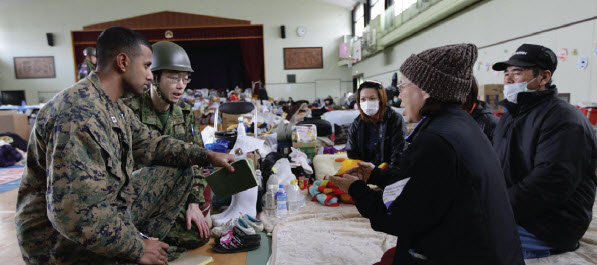
U.S. Marine officer meets with Japanese refugees in a school being used as a shelter.
Saturday, March 26, 2011
- The aircraft carrier USS George Washington conducts a vertical replenishment at sea and receives supplies from the fast combat support ship USNS Bridge.
- Weather severely impacts support operations, with 40+ mph winds, heavy snow, and ice accumulation on rotor and fixed wing aircraft experienced across the entire area of operation. Helicopters were unable to make any deliveries of relief supplies today.
- Commander Task Force 76 continues harbor clearance operations in Hachinohe today. USNS Safeguard with the embarked divers of Mobile Diving and Salvage Unit 1, Explosive Ordnance Disposal Mobile Unit 5, and Underwater Construction Team 2 work with Japanese Maritime Self Defense Force and commercial divers to open additional areas of the harbor for operations.
- USNS Carl Brashear conducts at-sea replenishment of fuel and humanitarian supplies with the USS Essex amphibious ready group, which includes USS Harpers Ferry, USS Germantown, and USS Tortuga. USNS Pecos conducts additional replenishment efforts with USS Chancellorsville, USS Shiloh, USS Preble and USS Mustin.
- The USS Curtis Wilbur returns to Yokosuka for resupply, making it the first U.S. Navy ship to return to Yokosuka since March 22.
Sunday, March 27, 2011
- Two barges containing 500,000 gallons of fresh water from Commander, Facilities Activities Yokosuka (CFAY) are en route to the port of Onahana to assist with the cooling of the crippled Fukishima Daiichi nuclear power plant. The first barge arrived during the evening hours escorted by the JMSDF ship, JS Hiuchi and the second barge will arrive tomorrow afternoon escorted by the JS Amakusa.
- The USS Essex Amphibious Readiness Group conducts an amphibious resupply of Oshima Island. The earthquake and resulting tsunami on March 11 severed utilities and destroyed ferry service, leaving the island largely without basic utilities or any form of resupply capability.
- A Navy P-3 “Orion” aircraft assists the mission in Oshima, scanning for obstructions in the water and coordinating with the LCUs during the transit from Kesenumma to Oshima. The aircraft captures images of additional outlying islands and passes that information to the JSDF for review.
- Rear Adm. Hiroyuki Kasui, commander of Japan’s Communications Control Center 1, arrives on USS Essex to review humanitarian assistance disaster relief operations and to thank U.S Navy Sailors for their assistance.
- USNS Rappahannock picks up 312 pallets of water from the port of Gwangyang, South Korea. The water will be moved to Sasebo for release to Fleet Industrial Supply Center – Sasebo Detachment who will support ongoing relief efforts.
- The Flying Tigers of HMM-262 helicopter squadron aboard the USS Essex move one ton of relief supplies from Essex to JS Hyuga for further distribution by JMSDF personnel.
- USNS Safeguard with the embarked divers of Mobile Diving and Salvage Unit 1, Explosive Ordnance Disposal Mobile Unit 5, and Underwater Construction Team 2 work closely with Japanese Maritime Self Defense Force JMSDF and commercial divers to open the LNG pier and additional areas of the Hachinohe harbor for operations.
- A Liquid Natural Gas (LNG) tanker docks at Hachinohe port to deliver much needed fuel for the thousands of displaced personnel still living in shelters without electricity or heat.
- Navy teams are working with the Japan Self Defense Force (JSDF) and local authorities to coordinate similar efforts in the ports of Miyako, Kamaishi, and Ofunato. USNS Safeguard is scheduled to transit to Miyako tomorrow.
- USS Preble conducts replenishment at-sea today with the USNS Pecos to onload additional fuel and ships stores depleted while supporting Operation Tomodachi.
- USS Blue Ridge, flagship for the United States Seventh Fleet, is on station in the Philippine Sea providing coordination for U.S. Navy efforts during the crisis.
- Currently, 19 ships, 133 aircraft, and 18,165 personnel of the Fleet are operating in support of Operation Tomodachi. Ships currently engaged include USS Ronald Reagan, USS Chancellorsville, USS Preble, USS Cowpens, USS Shiloh, USS John S. McCain, USS Fitzgerald, USS McCampbell, USNS Pecos, USS Matthew Perry, USNS Bridge, USNS Carl Brashear, USNS Safeguard, USS Essex, USS Harpers Ferry, USS Germantown, USS Tortuga, USS Blue Ridge, and USNS Rappahannock.
- Since Operation Tomodachi began, U.S. 7th Fleet forces have delivered more than 240 tons of HA/DR supplies to survivors of the tsunami and earthquake, in support of Japan Self Defense Force efforts.
Monday, March 28, 2011
- Residents of Oshima enjoy their first full day of having electrical power after the USS Essex Amphibious Ready Group and the Japan Self-Defense Force combined efforts to restore power.
- USNS Safeguard and USS Tortuga, Mobile Diving and Salvage Unit 1, Explosive Ordnance Disposal Mobile Unit 5, and Underwater Construction Team 2 move to the port of Miyako in preparation for port clearance operations there.
- USS Fitzgerald arrives in Yokosuka after conducting checks for radioactive contamination.
- The second of two U.S. Navy barges containing 500,000 gallons of fresh water from Commander, Facilities Activities Yokosuka arrives at the port of Onahama in preparation for transport to the crippled Fukushima Daiichi nuclear power plant. JMSDF personnel are conducting additional safety training and familiarization of the barges and pumping equipment prior to movement to a staging area off the coast from the power plant. The water will be used to replace salt water in the reactor cooling system to lessen the corrosive impact of salt from the sea water still being used for emergency cooling.
- USNS Rappahannock is en route to Sasebo with 312 pallets of water it picked up from the port city of Gwangyang, Republic of Korea, yesterday. The water will be used by Sasebo detachment of the Fleet Industrial Supply Center to support ongoing HADR efforts.
Tuesday, March 29, 2011
- USNS Safeguard and USS Tortuga, Mobile Diving and Salvage Unit 1, Explosive Ordnance Disposal Mobile Unit 5, and Underwater Construction Team 2 anchor in the port of Miyako in preparation of port clearance operations. Tortuga launches a Landing Craft Unit equipped with side scan sonar to survey the port.
- Helicopters from Marine Medium Helicopter Squadron 262 move 154 pallets of relief supplies from USS Essex, USS Germantown, and USS Harpers Ferry to the Misawa for transport to Sendai.
- USS Essex and USS Ronald Reagan move three pallets of hygienic supplies to the JS Hyuga.
- A P-3 “Orion” aircraft from the Snapdragons of Patrol Squadron Four conducts a search and rescue flight off the Tohoku coast to search for debris or objects at sea that could interfere with shipping.
- The first of two U.S. Navy barges containing 500,000 gallons of fresh water from Commander, Facilities Activities Yokosuka moves to the Fukushima Daiichi nuclear power plant. The second will arrive tomorrow. Japanese authorities will use the fresh water to replace salt water in the reactors.
- USS Blue Ridge, flagship for the United States Seventh Fleet, is on station near Okinawa providing command and control for U.S. Navy efforts during the crisis. Commander, U.S. 7th Fleet, has been designated as the Joint Force Maritime Component Commander for U.S. relief efforts in Operation Tomodachi.
Wednesday, March 30, 2011
- Seventh Fleet forces continue support of Japan Self Defense Force in Operation Tomodachi. With Sendai airport now open for military flights—and soon to be opened for commercial flights—7th Fleet’s focus has shifted to harbor clearance, consolidation of relief supplies, and debris clean-up.
- USNS Safeguard and USS Tortuga, Mobile Diving and Salvage Unit 1, Explosive Ordnance Disposal Mobile Unit 5 and Underwater Construction Team 2 conduct surveys in preparation of port clearance operations at the port of Miyako. Visual surveys show extensive damage including commercial and pleasure craft sunk, concrete pier supports washed ashore and a permanent pier destroyed.
- Sailors and Marines from the USS Essex amphibious ready group and the 31st Marine Expeditionary Unit plan for Operation “Field Day,” a clean-up mission on the island of Oshima off the coast of Kessennuma. In conjunction with the Japan Ground Self Defense Force, the effort will include clearance of the port and clearance of debris from local schools and government buildings. The island is dependent upon ferry service to and from the mainland.
- USNS Rappahannock and USNS Pecos arrive at the port of Yokosuka. The Rappahannock transports 312 pallets of water from the port city of Gwangyang, South Korea. The water will be used by Fleet Industrial Supply Center to support ongoing relief efforts in Japan.
- USNS Carl Brashear arrives in Sasebo. Both Pecos and Carl Brashear are taking on fuel and ships stores prior to returning to the fleet in support of relief operations.
- A P-3 “Orion” aircraft from the Skinny Dragons of Patrol Squadron Four conducts a search and rescue flight down the east coast of Japan to search for debris or objects at sea.
- USNS Bridge conducts resupply at sea activities with USS McCampbell, USS Preble, USS Chancellorsville, USS Mustin , USS Cowpens, and USS Shiloh, ships of the USS Ronald Reagan Carrier Strike Group. Most of the relief supplies on these ships have been moved ashore to airfields in Misawa or Sendai.
Thursday, March 31, 2011
- Japan Ground Self Defense Force Lieutenant General Eiji Kimizuka, Commanding General of Joint Task Force Tohoku in charge of the ground recovery efforts, meets sailors on board the USS Ronald Reagan and the USS Essex to express his gratitude for their efforts in Operation Tomodachi. Foul weather prevents General Kimizuka from returning to Sendai by helicopter, so he remains overnight on Essex, breaking his flag and making Essex the flagship—albeit temporarily—for Japan’s JTF Tohoku.
- USNS Safeguard and USS Tortuga, Mobile Diving and Salvage Unit 1, Explosive Ordnance Disposal Mobile Unit 5, and Underwater Construction Team 2 conduct additional survey and obstacle identification operations at the port of Miyako.
- Sailors and Marines from the USS Essex Amphibious Ready Group, the 31st Marine Expeditionary Unit, and Japan Ground Self Defense Forces continue preparations for Operation “Field Day,” a cleanup mission on the remote island of Oshima. Tomorrow, four Humvees, a dump truck, a water truck, and a fuel truck will embark two LCUs for movement to Oshima harbor to assist with debris clearance. The island, which is dependent upon ferry service from the mainland, has been isolated since March 11 when the tsunami washed its ferries ashore.
- One U.S. Navy barge containing 300,000 gallons of fresh water is moored at the Fukushima Daiichi nuclear plant, and the second containing an additional 200,000 gallons is expected to arrive tomorrow. Japanese authorities will use the fresh water to replace salt water in some of the reactors.
- USNS Richard E. Byrd conducts resupply at sea activities with the USS Essex, USS Tortuga, USS Germantown, and USS Harpers Ferry to provide those ships with needed stores and also to retrieve HA/DR supplies. Byrd also conducts a consolidation exercise with USNS Bridge. All HADR supplies are being consolidated aboard the Byrd for transport to Yokosuka for further distribution by the Japan Ground Self Defense Force.
- Two P-3 Orion maritime surveillance aircraft return to Kadena Air Base in Okinawa after 25 sorties and 138 hours of on-station flying time conducting aerial surveillance to identify groups of isolated persons, survey damage, and locate floating debris. All information gathered from these flights is shared with the Japan Self Defense Forces.
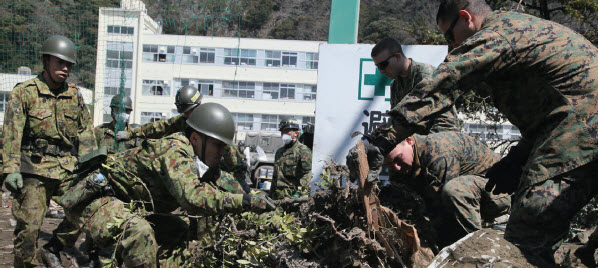
U.S. Marines and Japanese soldiers work together to clear debris at Minato Elementary School in Ishinomaki, April 1, 2011.
Friday, April 1, 2011
- Seventh Fleet forces continue support of Japan Self Defense Force (JSDF) in Operation Tomodachi. Today’s focus of effort is the grim task of searching for human remains off the Tohoku coast using both aircraft and surface searches, as the bodies of victims which initially sunk may rise back to the surface over time. Additional aerial reconnaissance and search sorties are scheduled for tomorrow. The Japan Self Defense Force requested U.S. assistance due to the size of the search area. Locations of remains will be marked and that data sent to the Japan Maritime Self Defense Force for retrieval and honorable interment of the victims.
- USNS Safeguard and USS Tortuga, Mobile Diving and Salvage Unit 1, Explosive Ordnance Disposal Mobile Unit 5, and Underwater Construction Team 2 conclude survey and obstacle identification operations at the port of Miyako.
- 187 Sailors and Marines from the USS Essex Amphibious Ready Group, the 31st Marine Expeditionary Unit supporting Japan Ground Self Defense Forces begin Operation “Field Day,” a clearing and clean up mission on the remote island of Oshima off the coast of Kessennuma.
- USS Harpers Ferry and USS Germantown will be released from Operation Tomodachi tomorrow and proceed to Okinawa. USS Fitzgerald, USS McCampbell and USS Mustin are in Yokosuka replenishing supplies and are planned to rejoin Operation Tomodachi upon completion.
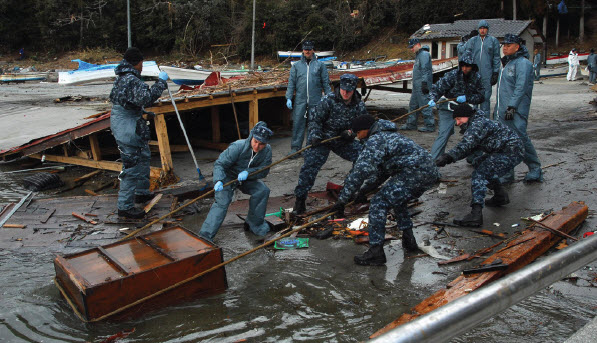
U.S. Navy sailors clear debris from a harbor in Oshima.
Saturday, April 2, 2011
- Seventh Fleet forces continue support of Japan Self Defense Force (JSDF) in Operation Tomodachi. Today’s focus of effort continues to be the search for human remains off the coast of Tohoku and clean up and clearance operations on the island of Oshima.
- Seventh Fleet ships, helicopters and aircraft are searching over 2,000 square miles of ocean in a concerted effort to find victims of the March 11 tsunami. USS Cowpens, USS Preble, USS Shiloh and USS Curtis D. Wilbur are searching for remains off the north east coast of Honshu, with their helicopters, additional support helicopters from the USS Ronald Reagan and one P-3 Orion aircraft providing aerial reconnaissance support.
- U.S. Navy barges containing 500,000 gallons of fresh water are moored at the Fukushima Dai-Ichi nuclear plant, adding this resource to the fresh water cooling efforts. Japanese authorities will use the fresh water to replace salt water currently in some of the reactors.
- USS Harpers Ferry (LSD 49) USS Germantown (LSD 42), USS Fitzgerald (DDG 62), and USS John S. McCain (DDG 56) are released from Operation Tomodachi today and will proceed with other tasking.
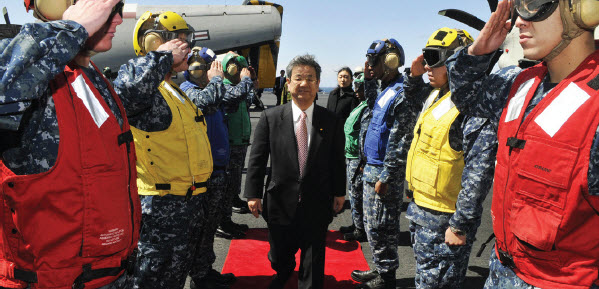
Defense Minister Toshimi Kitazawa receives honors from sailors upon his arrival aboard the aircraft carrier USS Ronald Reagan.
Sunday, April 3, 2011
- 150 additional Sailors and Marines from the USS Essex Amphibious Ready Group and the 31st Marine Expeditionary Unit join the 187-member team on the island of Oshima. The crew is taking part in Operation Field Day, a mission to support the Japan Ground Self Defense Force in cleaning up the island. Today, U.S. Sailors and Marines help the JSDF with efforts on the shores of the Uranohama harbor and will move to the shores of the Yogai and Komagata harbors in the next few days. As part of Operation Field Day, the team also continued clearing debris around Oshimatake Junior High School.
- USNS Safeguard and USS Tortuga, Mobile Diving and Salvage Unit 1, Explosive Ordnance Disposal Mobile Unit 5, and Underwater Construction Team 2 are en route to Oshima to assist Japan Self Defense Force with clearing debris in the harbors.
- The number of U.S. 7th Fleet forces actively engaged in the operation is currently 14 ships, 130 aircraft and 13,893 personnel. Since Operation Tomodachi began, U.S. 7th Fleet forces have delivered more than 260 tons of relief supplies to survivors of the tsunami and earthquake and flown 160 aerial reconnaissance and search sorties.
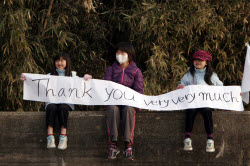
Two children and their mother thank Marines and Sailors of the 31st Marine Expeditionary Unit for cleaning up debris on Oshima Island. (Official Marine Corps photo)
Monday, April 4, 2011
- The Defense Minister of Japan, Toshimi Kitazawa, and other senior officials of the Japan Self Defense Force visit the USS Ronald Reagan to meet with the crew and offer gratitude for the service of the U.S. military during the crisis in Japan. Defense Minister Kitazawa shares a message from the Prime Minister of Japan, Naoto Kan, which expresses the Prime Minister’s appreciation for the 7th Fleet operations and states that “not only the victims of the disaster hit areas, but also the entire Japanese people are deeply moved and encouraged by the scenes of U. S. military member working hard to support the relief efforts. Both Japan and the United States are true ‘TOMODACHI’ (friends).”
- U.S. Ambassador to Japan, the Honorable John Roos; Adm. Patrick Walsh, Commander, U.S. Pacific Fleet and Joint Support Forces commander; and Vice Adm. Scott Van Buskirk, Commander, U.S. Seventh Fleet are among the U.S. dignitaries in attendance to accept Mr. Kitazawa and the JSDF delegation. Both the Ambassador and Adm. Walsh address the Sailors and Marines gathered in the hanger bay of the aircraft carrier to thank them for their selfless service to help the JSDF and the Japanese people following the tragedies on March 11.
- Sailors and Marines from the USS Essex Amphibious Ready Group and the 31st Marine Expeditionary Unit continue Operation Field Day, the mission to support Japan Ground Self Defense Force in the cleanup of island of Oshima. The team continues cleanup efforts on the shores of the Uranohama harbor and began cleanup efforts on the shores of the Yogai and Komagata harbors.
- USNS Safeguard, USS Tortuga, Mobile Diving and Salvage Unit 1, Explosive Ordnance Disposal Mobile Unit 5, and Underwater Construction Team 2 arrive at Oshima to assist Japan Maritime Self Defense Force with clearing debris in the harbors. Landing Craft Utilities and small boats equipped with side scan sonar scan the Uranohama harbor to determine locations of underwater hazards and obstacles while divers mark the locations for salvage operations.
- Representatives from CTF 76 port clearance operations, met with representatives of the Japan Coast Guard, JGSDF, and the Mayor of Kesennuma to determine areas of salvage and clearance focus. The channel between Kesennuma and Oshima was chosen as the area of concentration as it is the primary waterway that connects the open sea into Kesennuma and Oshima allowing trade ships access to the ports. After this meeting, landing craft utilities and small boats equipped with side scan sonar began scanning the Uranohama harbor bottom to determine locations of obstacles for divers to mark obstacles for salvage operations. The side scan sonar was successful in determining underwater hazards and obstacles during port clearance operations at the ports of Hochenohe and Miyako.
Tuesday, April 5, 2011
- Portable water heaters and shower facilities arrive from the USS Essex and Marines and Sailors assemble those facilities at a local elementary school on the island of Oshima. For many island residents, the showers provide them the first opportunity to bathe since the tsunami hit on March 11. The shower facilities are able to cycle through approx. 30 people per hour, but are only open during daylight hours to conserve energy usage. Establishing the hygienic facilities is one small part of Operation Field Day, the mission to support Japan Ground Self Defense Force in the cleanup of Oshima.
- Other Operation Field Day efforts include the continuation of cleanup efforts on the shores of the Uranohama, Yogai and Komagata harbors on the island.
- USNS Safeguard, USS Tortuga, Mobile Diving and Salvage Unit 1, Explosive Ordnance Disposal Mobile Unit 5 and Underwater Construction Team 2 postponed efforts at Oshima due to high seas and winds and will resume operations as soon as conditions clear.
- The USS Ronald Reagan Carrier Strike Group, which includes the USS Chancellorsville, USS Preble, USS Shiloh, and USS Curtis Wilbur, depart active support of Operation Tomodachi after receiving warm and heartfelt thanks from Japan.
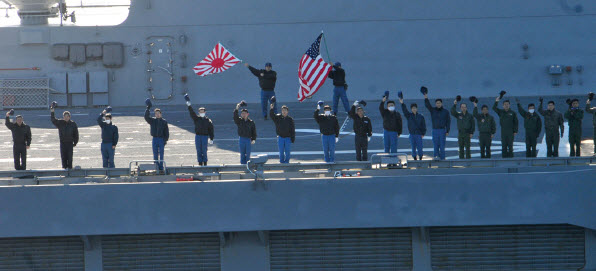
Sailors from the USS Ronald Reagan and JS Hyuga wave to each other.
Wednesday, April 6, 2011
- More than 40 Sailors assigned to the amphibious assault ship USS Essex volunteer assist with the clean-up efforts on the island of Oshima. The group clears away pieces of houses, personal belongings, boats, fishing nets and other debris. Japanese residents expressed their gratitude to the Sailors who participated in the clean-up process.
- Navy Adm. Robert F. Willard, commander of U.S. Pacific Command, testifies before the House Armed Services Committee about the U.S. defense posture in the region and the humanitarian and disaster assistance provided to Japan since the March 11 earthquake, tsunami, and subsequent nuclear emergency.
- Marines, sailors, and soldiers with Logistics Combat Element, 3rd Marine Expeditionary Brigade, having completed a variety of missions in support of the JSDF since March 18, concluded their participation.
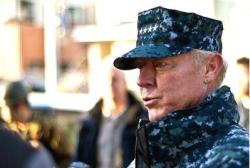
Admiral Robert F. Willard.
Thursday, April 7, 2011
- The Essex Amphibious Ready Group concludes its participation in Operation Tomodachi after conducting nearly three weeks of humanitarian assistance/disaster relief operations with the Japan Self-Defense Force.
- Marines and Sailors of the 31st Marine Expeditionary Unit depart Oshima Island after completing the clean-up of Uranohama Port and the surrounding areas during Operation “Field Day.”
Friday, April 8, 2011
- The crew of USS Tortuga, USS Safeguard, and EOD Mobile Unit Five present underwater survey data collected over the previous days in Kessenuma and Oshima to local officials, showing the precise locations of submerged navigational obstructions. U.S. Navy officials offered to continue with clearance efforts, but officials from Oshima and Kessanuma indicated that they would prefer for local salvage experts to take up the task.
- After the underwater survey data was delivered and crews returned to Tortuga and Safeguard, Joint Support Force released Essex, Tortuga, and Safeguard from further efforts in Operation Tomodachi.
- All U.S. Navy ships involved in Operation Tomodachi have now redeployed and are proceeding with other tasking around the region.
Footnotes
[1] Information compiled from U.S. Department of Defense website (http://www.defense.gov), Thomson Reuters (http://www.reuters.com), and COMPACFLT – Commander United States Pacific Fleet (http://www.cpf.navy.mil/)
Original chronology by Ryan Zielonka; revisions by Daniel Taninecz Miller and Jonathan Walton.
Opening photo credit: A U.S. Navy air crewman from Helicopter Anti-Submarine Squadron 4 surveys affected areas, March 21, 2011.


